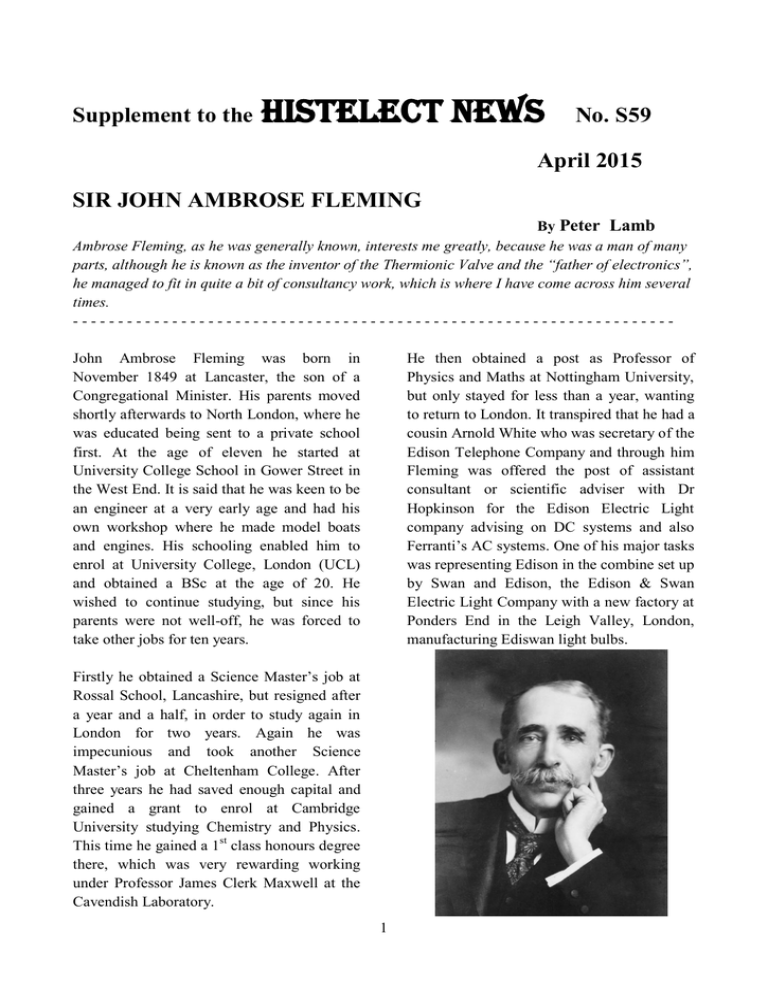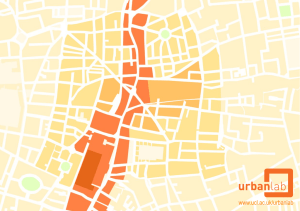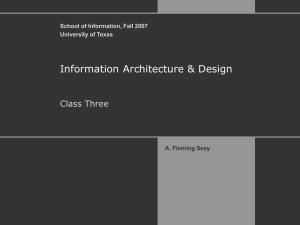SIR JOHN AMBROSE FLEMING
advertisement

Supplement to the Histelect News No. S59 April 2015 SIR JOHN AMBROSE FLEMING By Peter Lamb Ambrose Fleming, as he was generally known, interests me greatly, because he was a man of many parts, although he is known as the inventor of the Thermionic Valve and the “father of electronics”, he managed to fit in quite a bit of consultancy work, which is where I have come across him several times. ------------------------------------------------------------------John Ambrose Fleming was born in November 1849 at Lancaster, the son of a Congregational Minister. His parents moved shortly afterwards to North London, where he was educated being sent to a private school first. At the age of eleven he started at University College School in Gower Street in the West End. It is said that he was keen to be an engineer at a very early age and had his own workshop where he made model boats and engines. His schooling enabled him to enrol at University College, London (UCL) and obtained a BSc at the age of 20. He wished to continue studying, but since his parents were not well-off, he was forced to take other jobs for ten years. He then obtained a post as Professor of Physics and Maths at Nottingham University, but only stayed for less than a year, wanting to return to London. It transpired that he had a cousin Arnold White who was secretary of the Edison Telephone Company and through him Fleming was offered the post of assistant consultant or scientific adviser with Dr Hopkinson for the Edison Electric Light company advising on DC systems and also Ferranti’s AC systems. One of his major tasks was representing Edison in the combine set up by Swan and Edison, the Edison & Swan Electric Light Company with a new factory at Ponders End in the Leigh Valley, London, manufacturing Ediswan light bulbs. Firstly he obtained a Science Master’s job at Rossal School, Lancashire, but resigned after a year and a half, in order to study again in London for two years. Again he was impecunious and took another Science Master’s job at Cheltenham College. After three years he had saved enough capital and gained a grant to enrol at Cambridge University studying Chemistry and Physics. This time he gained a 1st class honours degree there, which was very rewarding working under Professor James Clerk Maxwell at the Cavendish Laboratory. 1 This enabled him to visit the Edison Laboratories in the USA. Edison had found that an evacuated light bulb with a second electrode would allow current to flow from one electrode to the other but only in one direction. It was then called the “Edison effect”, and was studied by many people over the next twenty years. At that time the Americans did not pursue this particular line of study, but Fleming would do so in the future. Following an endowment he became Pender Chair over the newly established Pender Laboratory at UCL. His consultancies took him to the West Country, firstly at Taunton where he advised the Taunton Corporation on their take-over of the Taunton Electric Light Company in 1891. Then later at Plymouth in 1894, where he later chose the site of the Prince Rock Power Station. He was appointed Scientific Adviser to the Marconi Company in 1899, a post he held for thirty years. In the next year, he was asked to specify the power plant necessary to produce the powerful electrical oscillations required by Marconi’s project of transmission across the Atlantic, which was extremely successful. A 25hp oil engine was specified by Fleming driving an alternator with associated equipment including condensers, which were all installed at Poldu in Cornwall in 1901 He was a popular lecturer at this time also travelling around the Country to major towns such as Newcastle, Liverpool and Biringham. By 1884 he was back at UCL this time as Chair of Electrical Engineering, the first of its kind in the Country at that time. This stable environment enabled him to get married to Clara Pratt three years later; he was then 37, but I guess he hadn’t had much time to think about such things before that!! UCL in 1880 viewed from Gower Street In the first ten years at UCL he spent considerable time studying transformer theory and was allowed to do Consultancy work. The low voltage testing was carried out at UCL, whilst the majority of high voltage research was carried out at a substation underneath the Adelphi Arches operated by London Electric Supply Corporation, which equipped him well for his consultancy work. At this time he was known for introducing the phrase “power factor”, in describing the difference between KVA and kilowatts. He is probably more well-known for “Fleming’s Right-hand Rule”, using one’s right hand in his teachings describing the direction of induced current when a conductor moves in a magnetic field in basic generator design, (see next column). Fleming’s Right-Hand Rule He designed electrical measurement instruments and was involved in the measurement of electrical resistivity in pure metals and alloys with Sir James Dewar at both UCL and the Royal Institution. He undertook a considerable amount of lecturing at these institutions in the early 1900’s. 2 In 1899 he was appointed Scientific Adviser to the Marconi Telegraph Company. He immediately specified the equipment and the power plant for the transatlantic signal transmission from Poldhu in Cornwall in 1901. Unfortunately Fleming didn’t make much money out of this, since Marconi held the patent. UCL before retiring in 1926 to Sidmouth in Devon? He has been described as born teacher and gave meticulously prepared lectures. He had a gift of originating and inspiring research and at least 120 papers were published in his name. He carried out experiments in the fields of photometry, electronics, wireless telegraphy and electrical measurements. From his carefully prepared lecture notes, he compiled a number of textbooks on electrical engineering, numbering in the order of 21 books, including 3 volumes of Electrical Educator; two volumes of which we have in our National Library at Cairns Road. His later studies and research were involved mainly in high frequency engineering, including Telegraphy and Telephony, so much so that UCL became the first college in Great Britain to establish a laboratory specifically for this branch of electrical engineering. He was awarded the Faraday Medal in 1928 and many others besides, but the most notable achievement possibly was being invited to join that very select group, The Royal Society. Fleming experimented with a variety of lamps obtained from the Ediswan Lamp factory at Ponders End made especially for him with a filament surrounded by a metal cylinder in a vacuum. He found that when connected to a battery only negative electricity would pass from the filament to the cylinder. He states “I accordingly called this instrument a valve”, naming it as an oscillation valve, which later became known as the Thermionic Valve or Diode. He patented the device in 1904, and this is often credited with the birth of the modern electronics industry. Tragically his wife died in 1917, but they had not produced any off-springs in those twenty years. He was a devout Christian, his father being a Congregational Minister and he has even been reported as having preached at St. Martins-in-the Fields. He was an accomplished photographer and painted water colours. He married again a popular young singer Olive Franks in 1928, she was then 30 and he an old man of 78; he must have been quite a lively old guy! Flemings Original Valve Much later HH Dunwoody of the De Forest Wireless Company used similar equipment that he had designed for Marconi such as the crystal detector and also two electrode valves with a double battery connection. He also patented a valve with a third electrode making it the first triode in 1906. Fleming challenged the second patent as infringing his patent. He retired to Sidmouth in Devon and remained active in engineering circles, becoming a committed advocate of television, which included serving as the first President of the Television Society. He was knighted in 1929 and died in 1945 at the great age of 96, so his young wife did inspire longevity! He stayed in the Chair of Electrical Engineering at UCL for over 40 years, , so what did he do in those last 20 years at the 3

